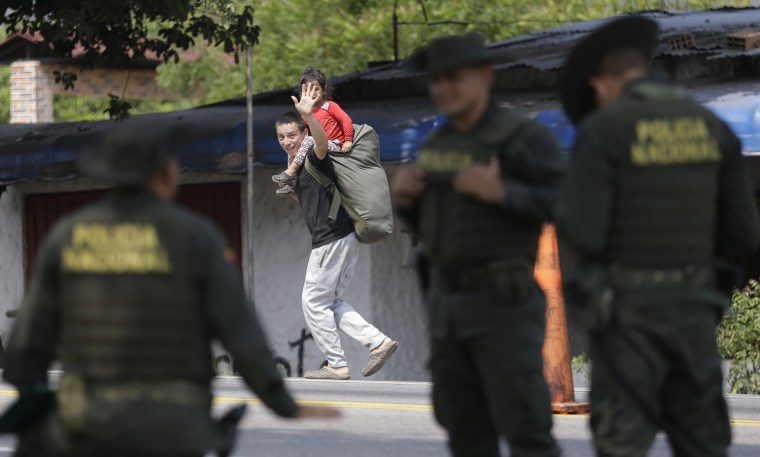Her brother, on the journey for a second time, knew better than to allow the harsh sun to crisp his skin and slathered his face with sunscreen, which had formed streaks on his forehead.
Outside the soup kitchen in Los Patios, about 4.5 miles (7.5 kilometers) inside Colombia, migrants quickly cram around an outdoor table once the chain link fence door opens.
Some learned from friends or other migrants about the operation, whose cooks prepare upward of 40 gallons of soup for each meal at two sites.
Jhon Alvarez, coordinator of the Fundación Nueva Ilusión — roughly New Hope Foundation in English — said he is increasingly seeing familiar faces at the soup kitchen.
“People are returning from the other countries — Chile, Peru, Ecuador, Bolivia — again to Venezuela, but after 15 days or a month they can’t stand it, and they come back,” Alvarez said.
Her brother, on the journey for a second time, knew better than to allow the harsh sun to crisp his skin and slathered his face with sunscreen, which had formed streaks on his forehead.
Outside the soup kitchen in Los Patios, about 4.5 miles (7.5 kilometers) inside Colombia, migrants quickly cram around an outdoor table once the chain link fence door opens.
Some learned from friends or other migrants about the operation, whose cooks prepare upward of 40 gallons of soup for each meal at two sites.
Jhon Alvarez, coordinator of the Fundación Nueva Ilusión — roughly New Hope Foundation in English — said he is increasingly seeing familiar faces at the soup kitchen.
“People are returning from the other countries — Chile, Peru, Ecuador, Bolivia — again to Venezuela, but after 15 days or a month they can’t stand it, and they come back,” Alvarez said.
He said they tell him, “’Look, I had to come back because the situation is still the same (or) it’s worse. They raised the minimum wage, yes they did, but there’s no work.’”
Nowadays, 48% of migrants surveyed by a network of assistance agencies cited lack of employment and low salaries as their main reason to leave Venezuela, while 40% mentioned difficulties obtaining food and basic services, according to the Venezuelan office of the United Nations High Commissioner for Refugees.
Maduro has taken steps to halt the country’s economic decline, chief among them ending strict foreign currency controls, leading to a de facto switch from the Venezuelan bolivar to the U.S. dollar. That broke a years-long cycle of hyperinflation and helped ease chronic shortages.
Rrestaurants, imported goods stores, exercise studios and other businesses have opened in the capital, Caracas. Maduro recently said the country’s economy grew 17.4% during the first three months of 2022.
But Venezuela still has one of the world’s highest inflation rates and about three quarters of the population lives on less than $1.90 a day, an international standard for extreme poverty. Many lack access to clean, running water and electricity.
“Hope is the last thing to be lost, but at the moment, there is none,” Frank Fernandez said as he tried to contact his family from the soup kitchen to let them know he had reached Colombia with his brother. They were headed to Chile, where Fernandez had worked for four years before testing his luck again in Venezuela.

The 19-year-old used to earn about $43 a day working construction in Chile. At home, he could only find work cleaning windshields at a gas station. He and his brother walked up to 25 miles (40 kilometers) a day until they entered Colombia along one of the hundreds of dirt roads across the border.
Data compiled by the Interagency Coordination Platform for Refugees and Migrants, which involves about 200 humanitarian organizations, show governments have recorded the arrival of 753,000 Venezuelan migrants, refugees and asylum seekers since November in 17 Latin American and Caribbean countries.
The platform’s data also show the overall population of such Venezuelans in those countries had declined slightly for a time last year, from 4,620,185 in January to 4,598,355 in July.
The platform’s figures don’t include all migrants as some countries don’t count those who are illegally present and they don’t include figures for other countries, such as the United States.
Pandemic lockdowns and border closures also have pushed migrants to riskier paths. Mexico recently imposed a visa requirement for Venezuelans, so instead of flying to a country bordering the U.S., Venezuelan migrants now often trek northward across Central America after crossing the Darien Gap, a roadless jungle straddling the Colombia-Panama border where thieves, swollen rivers, rough terrain and wild animals are common.
Panama’s government said 45,000 Venezuelans had entered its territory that way so far this year, up from only 3,000 last year.
Arbelys, the 13th of 14 siblings, said she did not know if she would get to enroll at school once she gets to Peru. She was not even sure where in Peru she would live.
An aid worker at a shelter near the border had warned her of the dangers she could face during the rest of the journey.
“My brothers tell me that nothing is going to happen to me,” said Arbelys, whose parents stayed behind. “Along the journey, I feel scared sometimes because (the aid worker) also told me about human trafficking and how they try to trick you. I’m very trusting, so that scares me a little.”
Follow NBC Latino on Facebook, Twitter and Instagram.





